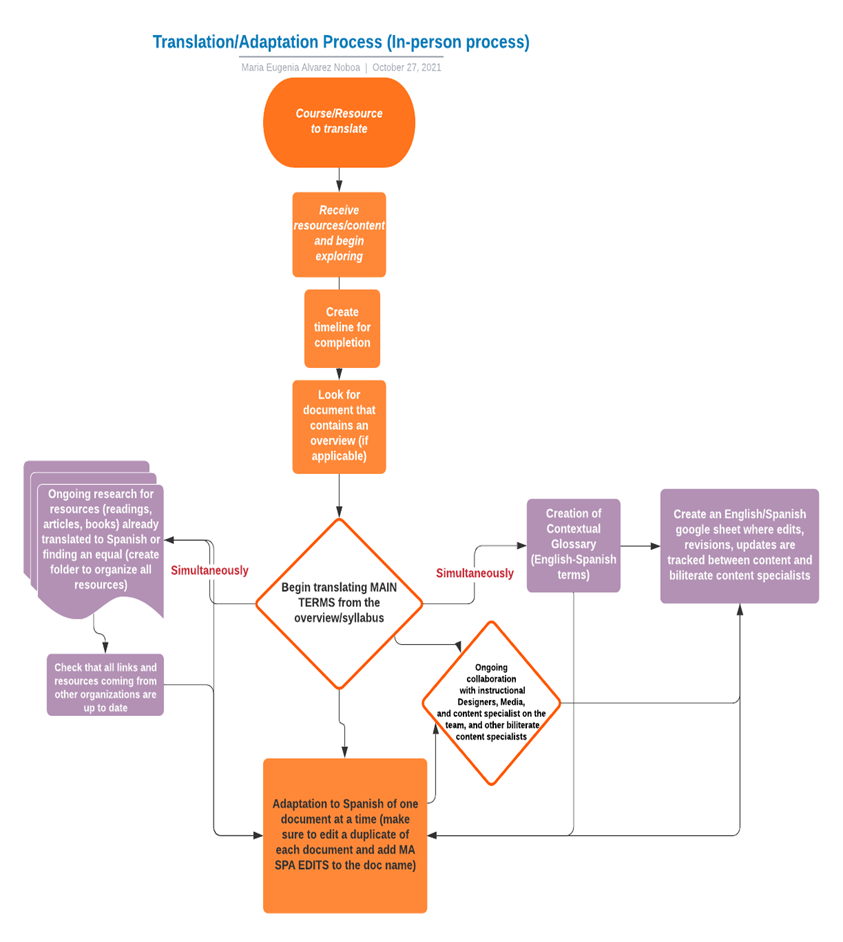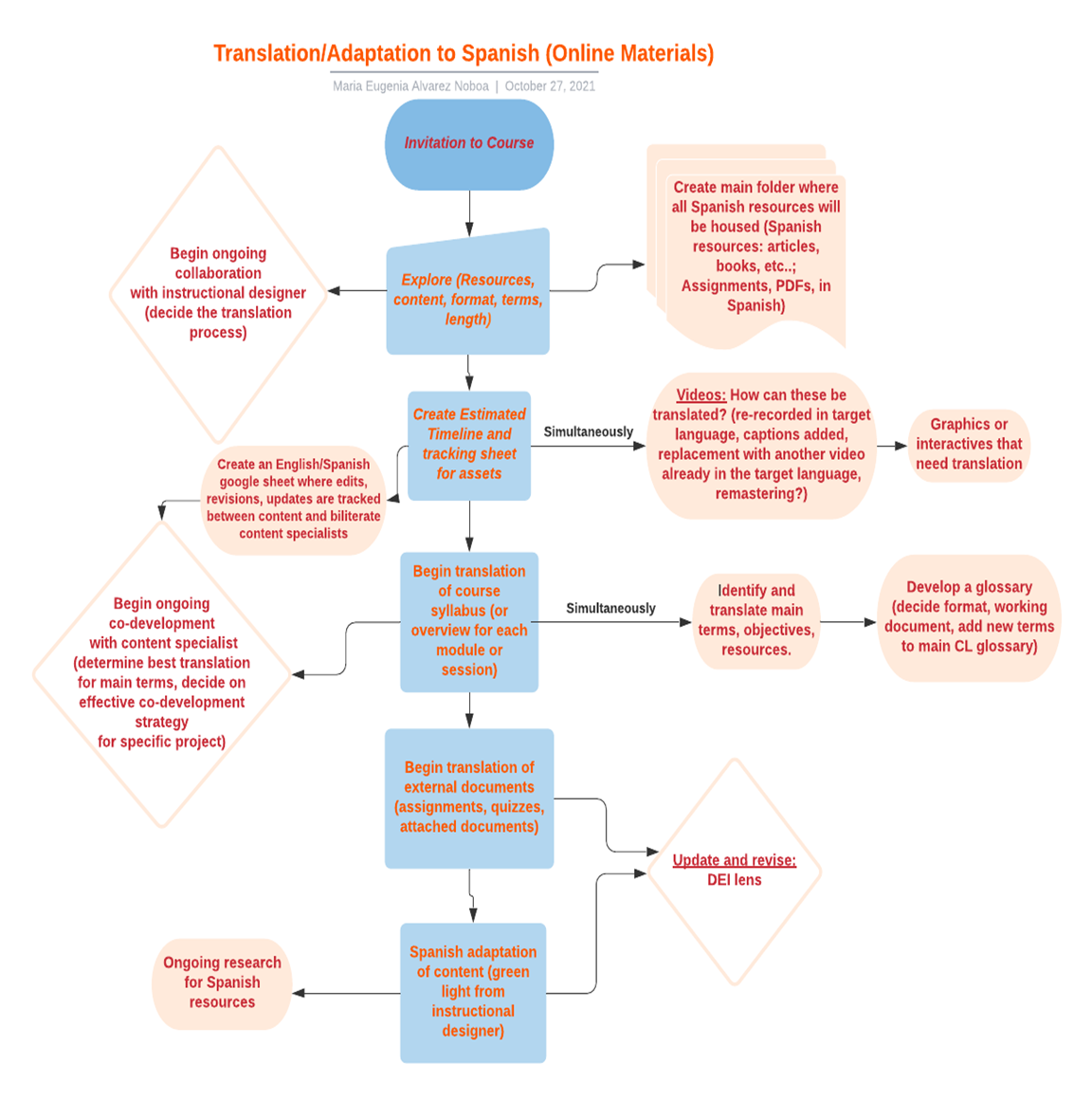Multilingual Product Development
Multilingual Processes
While all projects follow the guidance in the Content Writing at Culitvate Learning section, there are some additonal considerations for products that will be written in multiple languages.
For multilingual production, some of our products, deliverables, and materials are developed with a simultaneous multilingual approach. That is, they are written at the same time. They are co-created. Others require using a vendor for translation. When we are not creating products in a simultaneous manner, we follow strategies outlined in the Transcreation chapter.
Multilingual approaches to writing are outlined and embedded througout this Content Development and Style Guide as part of the writing style guide or specific production processes. Refer to all chapters in the Multilingual Product Development section overall for more details related to specific approaches, resources, and tips for writing.
Collaboratively Building Our Multilingual Glossaries
We appreciate the diversity of the audience for our products. As such, we create both a Culitvate Learning multilingual glossary and project specific glossaries. Project glossaries are written by the content team assigned to the project. We welcome contributions to our glossaries from educators in the field, partner organizations, and Cultivate Learning colleagues. This helps to ensure we are including different regional usages of the Spanish and Somali languages. (See Regional Uses and Differences section)
Project specific and Culitvate Learning glossaries help ensure consistency when materials are sent out to contracted translation vendors. With a “real time” glossary, we strengthen consistency in all of Cultivate Learning’s translated materials, at the same time that we build on the richness of the regional and cultural diversity of the Spanish and Somali languages.
Glossaries are updated on an ongoing basis by staff and partner organizations. New additions to the glossary are shared in the monthly Multilingual Workgroup meetings. Language specific terms and words are discussed in small groups in the monthly Multilingual Workgroup meetings.
Expore the the Cultivate Learning Multilingual Glossary and Multilingual Glossaries by Project chapters to find links to our current glossaries.
Regional Usages and Differences
Spanish
As we know, Spanish speakers in the U.S. may come from over 20 different countries, with their particular regional usages which differ in varying degrees from other speakers of the same language. At Cultivate Learning, we try to accommodate these differences depending on who the audience receiving the materials will be.
For materials to be distributed in Washington State, through the Early Achievers program or others, we prioritize the usage of terms familiar to the state’s Spanish-speaking or bilingual population, the majority of whom are descendents of generations of Mexicans and Central Americans, as well as more recently arrived immigrants from those regions.
For materials from EarlyEdU or others which will be distributed nation-wide, including to our colleagues in Puerto Rico, we frequently add terms used there and in wider regions, separated by a slash (/):
Examples:
- eyeglasses = lentes/espejuelos/gafas
- bucket = cubeta/cubo/balde
Somali
The Somali language is divided into three major dialects: Northern (the most common dialect and the basis for standard Somali), Benadir (on the Indian coast), and Maay (the southern part of the country). Generally, people from remote areas understand all dialects, although they may have different terms for different things.
Examples:
- Banana= Muus/Moos
- Girl= Gabar/Inan/Gabadh
- Fish=Kaluun/Malaay
- Drink= Abitaan/Cabitaan
Resources Shared Within Materials and Products
Some of our products include a resource handout or some other way of sharing resources with participants. When sharing additional resources like tipsheets, articles, and videos, prioritize quality and scope of the topics addressed, rather than 1-for-1 resource matching to the source langauge of the product. For exampe, a resource in Spanish may not have the exact resource in English. Focus instead on the content of that resource to determine what to share. The main focus is on identifying equivelant counterpart resources.
Some English websites may not be available in Somali or Spanish. In that case, identify specific Somali or Spanish language resources listed on that website. We can also keep in mind that most people who have access to websites will also have access to the Google translate feature for the website as a whole. This is particularly relevant to organizational websites (e.g. NAEYC, government sites), where a Spanish or Somali counterpart may not exist.
Be sure to review the Choosing and Using Visual Media part of the guide for additional guidance about choosing media and our multilingual media approach.
Vendor Translation Tips
Typically, the project manager (PM) moves materials through the translation phase. However, there are some key tips for content developers.
- All materials should be nearly final before sending for translation including. Content developers complete a Content Quality Check before translation.
- PMs submit all materials for translation. This might include WORD documents, slide decks, and Indd files (custom graphics).
- Materials are typically copy edited and sometimes simplified before translation.
- All graphics should be copy edited before submitting, too.
- The request needs to include a detailed summary of all translation needs.
- The project’s language glossary, when available, accompanies materials when submitted.
- PMs ensure materials are prepared for the language quality assurance phase when returned from the vendor.
- Biliterate content developers QA materials that have been translated by a vendor. *See the Reviewing Our Work and Language Quality Assurance chapters.
- Graphic designer reviews formatting as part of the final form and function review, after language QA.
- For Spanish – add footer: “NOTA DE TRADUCCIÓN: Por favor es importante que sepa que puede haber ligeras discrepancias y diferencias menores entre el texto impreso o electrónico en inglés y el correspondiente texto en español, debido a la edición y actualización de las diferentes versiones
- We typically caption videos to ensure accessibility and 508 compliance. At times, a transcript might be used instead. Media producers submit request forms for video captioning, transcripts, and translations. Captions are quality checked by the content developer before being applied to the relevant video. The captioning and translation process takes up to 4-8 weeks.
- When videos are to be translated, please have translators review the SRT/TextEdit texts together with the actual video, to make sure the speakers’ genders are correctly
represented. - If the originals are text only, have the authors make sure to identify the gender of the speakers and the people referred to. Words like “child” and “teacher” do not convey
gender and leave translators guessing, with little to work from.
- When videos are to be translated, please have translators review the SRT/TextEdit texts together with the actual video, to make sure the speakers’ genders are correctly
Translation Process for In-Person Courses (EarlyEdU)

Translation Process for Online Platforms (EarlyEdU)
Canvas

Rise
- Counterparts Light – download file
- ID takes the file and re-inserts into RISE.
